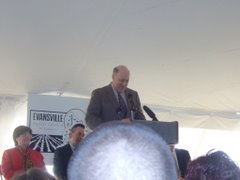(Ed.note. The following was noted in the Evansville Common Council minutes of August 8, 2006)
"Mr. Schwecke presented the Landowner-initiated comprehensive plan amendment, Phil Maas applicant (Application #2006-15). The Maas property is currently designated as agricultural/underdeveloped on the interim future land use map and on the future land use map it is shown as a location for future urban residential (walkable neighborhood) development. But the Maas property was left off of the Interim Future Land Use Map in an effort to control the rate of residential development in the city. This amendment does not automatically mean development of a residential subdivision on the Maas property. The landowner and developer would need to petition for annexation into the city, and the Common Council could refuse to grant annexation at this time. The applicant submitted an application to amend the interim future land use map to show the subject property as walkable neighborhood and neighborhood activity center so as to be consistent with the future land use map. The Plan Commission recommended passing this ordinance on a vote of 4-3. This project would push projected growth rates over target, assuming all other previously approved development projects built out.
The developer for this project, Mr. John Morning reported that currently residential development in Evansville is following a fairly conventional approach. Development of the subject property would create a type of housing not currently available in the city and would help to meet some key objectives in the city’s comprehensive plan. If this ordinance is approved, this would allow him to review all the development issues, and he would work with the city for win-win answers to all the issues. He is anticipating developing 90-100 lots over a period of five to eight years. Tonight, he is not asking to create lots, but the opportunity to review the development issues. He will move forward with this project only if it has a positive impact on the city.
Council discussed infrastructures, current developers agreements, and traffic connectivity on the west side of the city.
Mayor Decker opened the public hearing at 8:33 PM. The following people appeared before council and spoke against this ordinance:
Mark Schnepper, 547 S. Sixth Street
Elaine Strasburg, 16826 W. County C
Jim Brooks, 563 S. Sixth Street
Ayn Steinlein, 243 E. Main Street
Michael Pierick, 126 Grove Street
Matt Rohloff, 15903 W County C
Kendall Schneider, Town of Union Chairperson
Diane Skinner, 263 Garfield Avenue
Kelly Czerwonka, 215 Campion Drive
Matt Gaboda, 552 S. Sixth Street
Mayor Decker closed the public hearing at 8:50 PM.
The Council discussed that the Interim Future Land Use Map shows anticipated future development during the first 10 to 15 years after adoption of the plan. The long-term Future Land Use Map shows anticipated development more than 10 to 15 years after adoption of the plan, which is what the city wants to be in the future. The Smart Growth Plan is the city’s plan to move from the Interim Future Land Use Map to the long-term Future Land Use Map. The Council had to balance many of the same issues when they wrote the Smart Growth Plan. Balancing these issues for the Smart Growth Plan was very complex and difficult.
The Council reviewed how they must balance the intertwined issues of business interests, accelerating residential growth rate, importance of agriculture land, economic development, traffic connectivity, citizens’ interests, developers’ interests, impacts on municipal services, city’s demographics, city’s housing plan, concerns from the school district, and goals of the Smart Growth Plan. Balancing these issues is still very complex and difficult. For example, the Council discussed the traffic concerns in this area and how, currently, traffic must drive through the downtown when traveling north to Madison. If the area was developed, the traffic going to Madison from the Westside of the city could be routed away from the downtown, which is a goal of the Smart Growth Plan. Satisfying this traffic goal would violate the Smart Growth Plan’s goal of controlling the city’s growing population because this new subdivision would push the city’s available lots for new homes over its cap for the next 10 years. From tonight’s public hearing, other public input, and the Smart Growth survey, more than 90% of the citizens expressed concerns about accelerating the growth rate in the city’s population. The consensus was the negative impacts from this ordinance out weight the public benefits.
Motion by Cothard, seconded by Hammann, to call the question. Motion passed.
Motion by Hammann, seconded by Braunschweig, to adopt Ordinance #2006-20, amending the interim future land use map contained in the City’s Comprehensive Plan in response to development application 2006-15, amending the document on page 1, line 31 by replacing the “(d)(4)” with (4)(d).” The motion failed unanimously on a roll call vote.
Friday, August 18, 2006
Evansville Common Council: Minutes: Council denies Application 2006-15 to Amend Smart Growth Plan
Subscribe to:
Post Comments (Atom)






























No comments:
Post a Comment